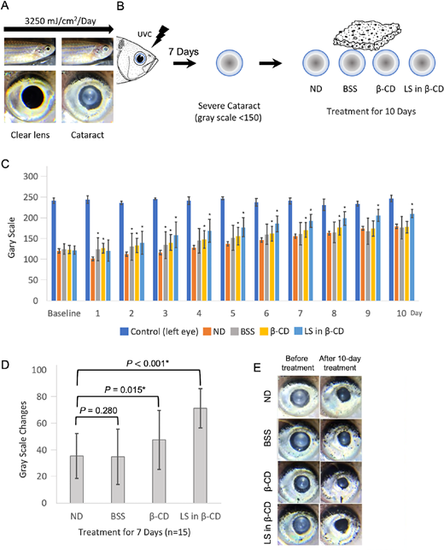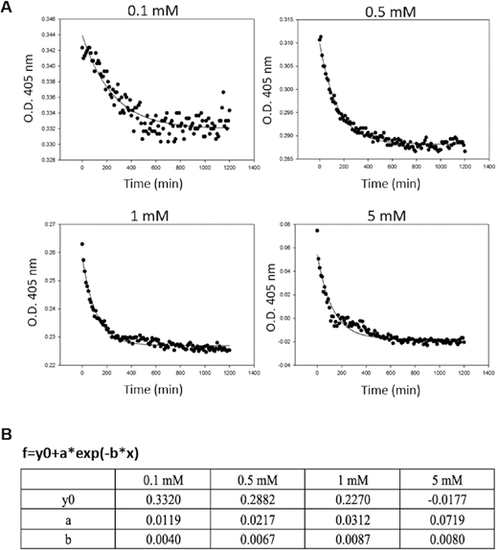- Title
-
Zebrafish (Danio rerio) Is an Economical and Efficient Animal Model for Screening Potential Anti-cataract Compounds
- Authors
- Liu, C.F., Ou-Yang, Y., Huang, C.Y., Jao, S.W., Kuo, Y.K., Chen, H.C., Cheng, S.C., Wang, N.K., Chuang, L.H., Chen, Y.H., Chen, W.Y.
- Source
- Full text @ Transl Vis Sci Technol
|
Constitutive lanosterol treatment reversed cataract in zebrafish. (A, B) Schematic of experimental procedure using zebrafish. (C, D and E) Schematic of experimental results. (A) The lenses of zebrafish were irradiated by 254 nm UV-C at a dosage of 3250 mJ/cm2/d for 7 days to induce cataract. (B) After cataract induction, the fish with a severe cataract phenotype were divided into four treatment groups as follows: no drug, BSS, β-CD, and lanosterol (LS) in β-CD. Lenses were covered with a compound-infiltrated sponge for five minutes twice a day for 10 days. The zebrafish were anesthetized and photographed using the same method used for cataract induction. After a 5-μL instillation of the intended compound, a 5 × 5 mm sponge infiltrated with the intended compound was applied on the right eye. After five minutes, the zebrafish was placed in a dark water tank for 60 minutes to recover from the anesthesia. (C) Gray-scale quantification of lenses of fish in the experiment. The results are expressed as means ± standard deviation. Gray scale 255 indicates totally clear, whereas 0 means totally opaque. The average gray scale of the untreated left eye was 241 at the beginning of the experiments, and the value was stable throughout the course of the experiments. Asterisks indicate significant differences (P < 0.05, independent t-test) between ND and other groups. (D) Changes in gray scales after seven days treatment with indicated compounds. Detailed gray scales of lens and sample numbers are summarized in Supplementary Tables S1 to S4. *P < 0.05, independent t-test. (E) Images of day 10 zebrafish lenses treated with no drug, BSS, β-CD, or LS in β-CD.
PHENOTYPE:
|
|
The treatment effect is sustained for three days after cessation of lanosterol treatment. (A) Schematic of cataract induction and lanosterol treatment. Zebrafish with severe cataract were treated with β-CD and lanosterol (LS) for 7 days followed by observation without treatment for three days. (B) Gray-scale values of zebrafish lenses. The results are expressed as means ± standard deviation. Details of gray-scale values of lens and sample numbers are summarized in Supplementary Tables S5 and S6. *P < 0.05, independent t-test. |
|
Lanosterol enhances the speed of clearing of extracted porcine lens protein in vitro. (A) The turbidity clearance assay of the effect of the indicated concentration of lanosterol on extracted porcine lens protein. The turbidity was monitored every 20 minutes for a total of 20 hours. The exponential regression curves (solid lines) are shown. O.D., optical density. (B) The equation and parameters for the exponential regression curves in (A). (y0 = remaining amount, a = clearable area, b = clearing speed, exp = exponent, x = time). |
|
Lanosterol reverses the loss of transparency of isolated porcine lens ex vivo. (A) Schematic of soaking assays. The isolated porcine lenses were treated with Jao-Liu (JL) solution for two days followed by incubation with vehicle β-CD and lanosterol (LS) in β-CD solution for eight days. The clarity of lenses was determined every two days. The detail baseline and treatment data are summarized in Supplementary Table S7. (B.) Gray-scale quantification of porcine lenses. The results are expressed as means ± standard deviation. Detailed gray scales and sample number are summarized in Supplementary Tables S8 and S9. *P < 0.05, independent t-test. |




